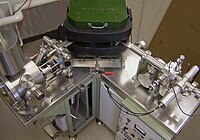
Photo from wikipedia
Abstract In order to explore the application value of the stable carbon isotope discrimination method in improving water use efficiency (WUE) and productivity of kiwifruit under deficit drip irrigation, five… Click to show full abstract
Abstract In order to explore the application value of the stable carbon isotope discrimination method in improving water use efficiency (WUE) and productivity of kiwifruit under deficit drip irrigation, five water deficit levels (55 %, 65 %, 75 %, 85 % and 100 % of full irrigation) with thirteen treatments were established at three growth stages in field-grown kiwifruit. The leaf stable carbon isotope discrimination (ΔL) at different growth stages and fruit stable carbon isotope discrimination (ΔF) at fruit maturation stage of kiwifruit were determined; the changes of WUE at leaf and yield levels were analyzed, and the indicating effect of carbon isotope discrimination (Δ13C) on the WUE of kiwifruit was also verified. The results showed that moderate water deficit improved the WUEi (photosynthesis rate/transpiration rate, Pn/Tr) and WUEn (photosynthesis rate/stomatal conductance, Pn/gs) of kiwifruit at each growth stage. Compared with full irrigation (CK), the yield (Y) and WUEy (yield/crop evapotranspiration, Y/ET) of low water deficit treatment (LD) at fruit maturation stage increased by 14.75 % and 23.74 %, respectively. There were significant relationships between ΔL and ΔF versus WUE, Ci/Ca (the specific value of intercellular CO2 concentration and ambient atmosphere CO2 concentration), CE (carboxylation rate), ET (crop evapotranspiration) and Y under deficit drip irrigation, respectively. ΔL was negatively correlated with WUEn (coefficient of determination, R2=0.4844, P
Journal Title: Agricultural Water Management
Year Published: 2020
Link to full text (if available)
Share on Social Media: Sign Up to like & get
recommendations!